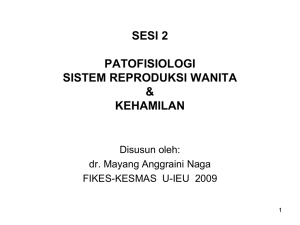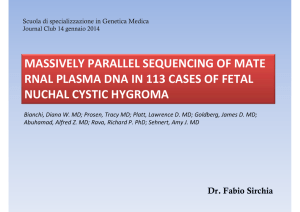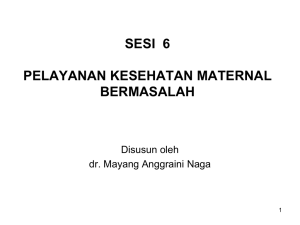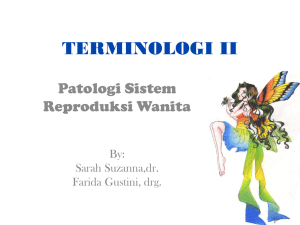slide kebidanan dan kemajiran
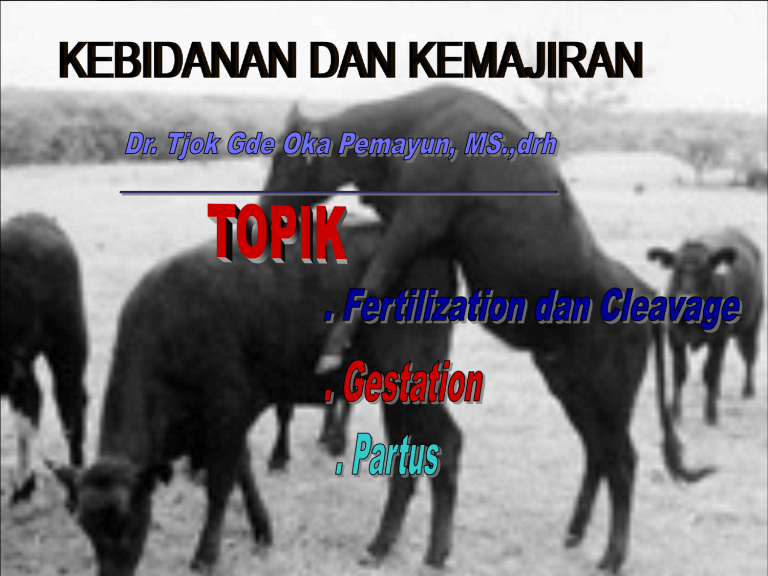
FERTILISASI : PERTEMUAN ♀ x ♂
(Prose's penyatuan 2 gamete)
Untuk mencapai inti ovum spermatozoa hrs melewati
1. sel granulosa
2. Zona pellusida
3. dinding sel ovum
(membran vitellin)
• Kepala sperm menempel pd zone pellucida
(receptor zp)
• Ab antizona: memblok penempelan sperm
• Ikatan ZP dpt dihambat dg Ab antisperm atau glikoprotein yg diekstrak dr ZP.
• G lycosyl transferase, proteinase dan glycosidase pd lapisan membran plasma kepala sperm dpt menghasilkan ikatan pada ZP3
PENETRASI SPERM
Untuk masuk ke dalam sel ovum, spermatozoa terlebih dahulu harus menembus:
(a). Massa kumulus (bila masih ada)
(b). Zona pelusida
(c). Membran vitellin
Pertautan kepala sperma dengan permukaan membran vitellus .
aktivasi sel ovum
Diepididymis (10 – 15 hr)
Maturasi tergt dari sekresi epididymis dan waktu transport
Motility/hyperactivation
Di Ampula,
Sp aktif bergerak (ampula mengandung zat spt: bicarbonate, pyruvate, asam amino bebas,oxygen, karbohidrate, steroid, Co2 dan nucleosides) produk sel-sel mukosa ampula
Bag kepala sp mengandung enzim hyaluronidase yg berfungsi mencairkan asam hyhaloronate diantara sel-sel granulosa
Sp menembus dd zp dan kepala sp bersentuhan dg membran vitellin dan terjadi reaksi zona (untuk mencegah sp lain masuk )
Reaksi zona zat yg dilepaskan oleh granula kortika yg terdapat diluar membran vitellin
RZ : jelas pada domba, tapi tdk jelas pada babi
(antara m.vitellin dan zp sering ditemukan lebih dari 1 ekor sp.) dan kelinci ± 200 sp
Pd hw yg tdk mempunyai RZ, mempunyai
Vitellin Blok
RZ dan VB sangat penting karena ovum dan sp adl sel-sel haploid
Haploid + haploid
Diploid
(berkemb normal)
Supplementary sperm
(sperma suplemen):
Pada ruang ZP lebih dr 1 sp
• Mengetahui lifespans (fertilitas) ovum dan sperm
• Waktu ovulasi (tgt sp.hewanya)
• Kosent sperm ( hanya 1.000 – 10.000 sp mencapai istmus) dan hanya 10 - 100 sp yg mencapai ampula setelah 4 sampai 12 jam
Seleksi pada uterotubal junction, isthmus (babi) vagina, servik, uterus (ruminansia
Mencegah polispermi
Setelah Fertilisasi
(Reaksi Acrosoma)
Intracellular calcium oscillations
Cortical reaction
Zona reaction
Block of polyspermy
Istilah: supernumenary sperm (Sperma Supernumerik) : bila sudah terjadi RZ dan VB, tapi dlm vitellus didapat lebih dari 1 sp
Polispermia gagal fertilisasi ( jmlh kromosum > dr normal) fertilisasi Triploid kebunt. mati
PENJIWAAN SPERM DAN OVUM
•
Kepala sp menyentuh membran vitelin
•
Reaksi membran ditandai, adanya tonjolan kecil pd membran
•
Kepala dan seluruh tubuh sp masuk kedlm sitoplasma sel ovum
•
Membran plasma yg menjadi pembungkus sp lebur menjadi satu dg membran vitellin
• Pengkerutan protein dan pembelahan inti sel ovum yg terakhir
• Hasil pengkerutan: dikeluarkannya cairan kedalam rongga antara zp dan vitellin
• Hasil pembelahan inti sel ovum menghasilkan polar bodi
Kepala sperma terlepas dg bagian lainnya dan menggembung
Period of Cleavage
• zygote
• blastomeres
• morula
• Fertlisasi Zygote (gamet)
2 cell, 4 cell, 8 cell, 16 cell dan 32 cell
(Dlm Zona Pelluucida)
32 cell (stadium morulla)
–
Cairan terlihat terkumpul diantara cel morulla Balstocoele
–
Tubuh embrio terlihat terbagi 2, karena ada bag sel yg tumbuh membentuk lapisan tipis dibag permukaan
–
Bag luar disebut Trophoblast
–
Bag dalam
Plasenta inner cell mass Mahluk baru
32 cell (stadium morulla)
• Cairan terlihat terkumpul diantara cel morulla
Balstocoele
• Tubuh embrio terlihat terbagi 2, karena ada bag sel yg tumbuh membentuk lapisan tipis dibag permukaan
• Bag luar disebut Trophoblast Plasenta
• Bag dalam inner cell mass Mahluk baru
•
Morolla masuk uterus trophoblast
Blastocyst yg mempunyai
•
Fungsi trophoblast : menyerap cairan yg mengandung nutrisi bagi embrio
•
Pada beberapa mamalia zp pecah setelah Blastocyst menyentuh endometrium Implantasi
•
Cairan uterus memp. peran sangat penting dalam menunjang kehidupan embrio menjelang implantasi (spt;
Glysin, alanine, taurine dan glutamine )
Time of Events in Early Embryonic Development spesies
Cattle Horse Sheep Swine
Gamet Longevity (Hours )
•
Sperm 30-40 72-120 30-48 34-72
•
Ovum 20-24 6-8 16-24 5-10
Ebryonic Development (days)
•
2- cell 1 1 1 0,6-0,8
•
4-cell 1,5 1,5 1,3 1
•
8-cell 3 3 1,5
•
Blastocyst
2,5
7-8 6 6-7 5-6
•
Hatching 9-11 8 7-8 6
Blastocyst Transport to Uterus
Hours 72-84 140-144 66-72 46-48
Cell stage 8-16 Blastocyst 8-16 4
Blastocyst Elongation (days) 13-21 11-16 11-15
Initial Placentation (days) 22 17 15 13
Birt ( days) 278-290 335-345 145-155 112-115
AWAL PERKEMBANGAN ENBRIO
IMPLANTASI
Proses implantasi adl proses yg berlangs scr bertahap
1.
Persentuhan embrio dengan endometrium
2.
Terlepasnya Zona pellusida
3.
Pergeseran atau pembagian tempat ( polytocous )
4.
Pertautan trophoblast dengan epitel endometrium
Pecahnya Zp: - ada sebelum menyentuh endometrium (beberapa mammalia)
- setelah menyentuh endometrium (marmot) akibat adanya juluran-juluran protein yg berasal dr trophpbalst (akibat reaksi dr embrio)
Hewan Polytocous: mekanisme penyebaran embrio disebut dingan mekanisme kontraksi uterus
Pecahnya Zp:
• ada sebelum menyentuh endomet (bbrp mammalia)
• setelah menyentuh endometrium (marmot), akibat adanya juluran protein yg berasal dr trophpbalst (akibat reaksi dr embrio)
Hewan Polytocous: mekanisme penyebaran embrio disebut mekanisme kontraksi uterus
(Spacing embrio)
Implantasi terjadi: bila embrio telah bertautan dengan endometrium dan tempatnya tdk berubah
SIFAT IMPLANTASI
•
Embrionya terbenam dalam kripta endomet (seluruh trophoblast berhub. sangat erat dng dinding kelenjar endomet) hewan pengerat (rodentia)
•
Emb. hanya bersentuhan dng epithel endomet (pertautan terjadi karena penjuluran protein trophoblast ke endomet sehingga seluruh tubuh embrio masih berada dlm lumen uterus sifat implantasi mengambang (sulit ditentuka
Domba
: implantasi ± hr ke 10-22 setelah IB
Sapi: hr ke 11 – 40
Model implantasi kedua sp ini adl sangat rawan
Implantasi pd babi
• Setelah 1,5 – 2 hr di tuba : embrio masuk utereus
• Spacing embrio (pengaturan tempat embrio) 10-15 hr
• Terlepasnya zp (sebelum implantasi)
• Stl Implantasi: trophpblast tumbuh cepat
• Nutrisi untuk embrio berasal dr uterus Histotrophe
(susu uterus)
• Terjadi hubungan yg erat antara trophoblast dengan endometrium terbentuk plasenta
Domba
• 3hr post ovulasi morulla dan memasuki lumen uterus
• Morulla blastula
• Blastula melayang-layang dlm histotrophe (17 hr post ovulasi) Masih dapat di flushing
• Db. Mempunyai karunkula dan tersebar diseluruh permukaan endomet
• Jumlah karunkula terbanyak adl pada curvatura mayor dr cornua uteri dan mempunyai demensi lebih besar drpd di bagian apex cornua uteri
• Karunkula berbtk mangkok (cotyledonaria) jml ± 90 buah
• Terjadi persentuhan antara trophoblast dg epitel karunkula
• Sel-sel trophoblast masuk dalm cell vili pada karunkula pertautan yg sangat erat
• Hr ke 30 implantasi selesai
Sapi
• Hampir sama dg db (karunkula)
• Jumlah embrio hampir sama 1-2 buah
Bedanya: faktor waktu dan kemungkinan terjadinya anastomosa bila kembar (tidak pd domba)
• Anastomosa (kembar ♂♀) Freemartin (majir)
• Implantasi lebih lambat yi. ± 33 hr
• Karunkula berbtk spt bunga kol (cotyledonaria) jml 100 -110
KOTILEDON / CHORION
Endometrium
KARUNKULA
Endometrium
Plasentoma
Membran Slip
PADA KUDA
• Blastocyst dapat hidup dlm susu uterus sampai 60 hr
• Ukuran embrio tdk mengalami perkemb yg cepat (± 5 cm)
• > 60 hr, trophoblas tumbuh vili-vili terjadi pertautan
• Umur 14 mgg (3,5 bln) implantasi terjadi
PLACENTATION
Tenunan tubuh embrio dan induknya, yg terjalin waktu pertumb. embrio untuk keperluan penyaluran makanan dr induk ke anak dan zat buangan dr anak ke induk.
Kebuntingan muda : jr tubuh embrio paling luar menjadi
Amnion , allantois , chorion dan kantong kuning telur
( yolk sac )
Amnion : bag yg menyelubungi fetus dibagian paling dalam
Khorion : bag yg menyelubungi fetus dibagian paling luar
Allantois : bag yg terdapat diantara amnion dan khorion
• Lapis sel allantois dibag dalam menjadi satu atau berhimpitan dg sel-sel membrana amnion
• Lapis luar berfusi atau berhimpitan dng sel-sel membrana khorion
• Arteri dan vena dr plasenta ke tubuh embrio berada pd lapisan membrana allantois dan khorion
• Adanya ruang amnion yg berisi cairan yg konsistensinya agak kental
Fungsi cairan amnion : mengurangi getaran atau goncangan dr luar tubuh induk dan sbg tempat penampungan zat buangan dr embrio mll urethra.
• Cairan allantois konsistensinya lebih encer memungkinkan bagi fetus mengikuti perubahan posisi induk
Fungsi : sebagai tempat pembuangan urin melalui pusar.
urachus (sal urin yg menghubungkan kantong urin dan kantong allantois melalui tali
• Kantong kuning telur tehenti tummbuh setelah kantong amniom dan allantois terbentuk seutuhnya
Placentation
Reptilian Chorioallantoic Placenta
Chorioallantoic placenta of the lizard Mabuya
Mammalian Placentation
• Transitory placentae exist in most species
– Yolk sac
– Chorionic
– Chorioamniotic
• Chorioallantoic – formed by chorion,
• Chorioallantoamniotic – final placenta
Chorionic Connective Tissue
• Embryo travels down tube and enters uterus
• Embryo interacts with wall of uterus
– Implantation
– Maternal recognition of pregnanc
Trophoblast
• expands and forms placental tissues
• 2 types
•Cytotrophoblast
•Syncytiotrophoblast
• Cyto - main region of the placenta
• Syncytio- invasive tissue
Uterine Response
•Decidualization
•Inflammation response endometrium overgrowsembryo
Inflammation response
• endometrium overgrows embryo
• decidualization
Placental Shapes
• Diffuse
– Horses, camels, pigs, dolphins
• Zonary
– Carnivores (raccoon, dog, cat)
• Cotyledonary (placentomes)
– Cows, sheep
• Discoid
– Primates, rodents, rabbits, insectivores
Discoid
Cotyledonary
Zonary
Diffuse
• Zonary
– Dog, Cat
Paraplacenta
(pigmented)
Chorion
STRUKTUR HISTOLIOGIS
FETUS
Kapiler
INDUK
Endothel
Jar. Ikat
Endothel
Epitel
Chorion
Epitel
Endometrium
Jar Ikat
STRUKTUR HISTOLIOGIS
• Macamnya dibedakan berdasarkan jumlah lapisan tenunan sel yg memisahkan aliran darah induk dan anak
• Ada 5 struktur scr histologis
1. epiheliochoreale
2. syndesmochoreale
3. endotheliochoreale
4. hemochreale
5. hemoendothelia
Ephiteliochoreale : tdp pd tipe P difusa (kd) darah induk dan anak dipisahkan oleh 2 lapis epitel, 2 lapis endotel, dan 2 lapis tenunan pengikat yg masin-masing berasal dr endo dan trophoblast syndesmochoreale : tdp pd tipe P. cotyledonaria (sp,kb,db) darah anak dan induk dipisahkan oleh 3 lap. Tenunan sel yi.
Endotel, tenunan pengikat dan tenunan epitel trophoblast (dr anak). Dari induk hanya endothel endotheliochoreale : tdp pd tipe P. zonaria (aj, kc)
Hemochreale : tdp pd tpe plasenta diskoidales (man, mencit, tikus, marmot dan kelinci) mempunyai lapisan pemisah darah anak dan induk lebih tipis dan dipisahkan oleh 3 tenunan lap sel yg berasal dr trophoblast (endotel, t.pengikat dan ep. trophoblast)
Hemoendothelia : (hemo = darah, endothel = epithel p.darah) darah induk dan anak hanya dipisahkan oleh 1 lapis tenunan sel yi endothel dr p.darah anak (tdp pd kelinci dg tipe P.diskoidale)
Placental Classification
• Based on number of layers separating fetal and maternal blood
Syndesmochorial (Epitheliolchorial)
(Ruminants )
Binucleate giant cells (unique)
• Transfer placental lactogen
• Secrete pregnancy specific protein B
• Steroidogenesis
Endotheliochorial (bitch, queen)
Complete erosion of endometrial epithelium and interstitium; maternal capillaries exposed to chorionic epithelium
Hemochorial (primates, rodents)
Maternal blood in contact with chorionic epithelium
Hemoendothelial (rabbit, rat, guinea pig)
Maternal blood in contact with chorionic capillaries
Placental Transfer
•
Simple diffusion
– Water, gases
•
Facilitated diffusion
– Glucose, amino acids
•
Active transport
– Na, K, Ca
•
Not transferred:
– Immunoglobulins (species dependent)
– Proteins
– Lipids
•
Transferred
– Steroid hormones
– Toxic substances (pharmaceuticals, heavy metals)
– Microorganisms (viruses, bacteria)
Placental Hormone Production
Maintenance of pregnancy
Stimulation of ovarian function
Stimulation of mammary gland
Promotion of fetal growth and maturity
Assist in parturition
Placental Hormones:
Chorionic Gonadotropins
• Equine (eCG)
– LH like activity in horses
– FSH activity in others
– Produced by endometrial cups
Placental Hormones:
Chorionic Gonadotropins
•
eCG
– LH-like
– Secondary CL’s
– Accessory CL’s
Placental Hormones:
Chorionic Gonadotropins
•
Human ( hCG )
–LH like activity
– Present in urine of pregnant women
–Used to induce ovulation, luteinization
Human Hemochorial
Maternal Recognition of Pregnancy
•
Prevention of luteolysis
– Anti-luteolytic
– Luteotrophic
•
Maintenance of elevated progesterone
Cow, Ewe
Trophoblastic protein
- Interferon tau
Cow: bIFNτ (btp-1)
Ewe: oIFNτ (otp-1)
- Produced by trophoblast, d 13-21 post ovulation
Inhibits oxytocin receptor synthesis by endometrium
Also promotes protein synthesis by endometrial glands for embryo survival
Sow
•
Estradiol
– Produced d 11-12 post ovulation
– Increases prolactin receptors
– Promotes exocrine secretion of PGF
– Stimulates uterine contractions to distribute fetuses
– Minimum 2 conceptuses per horn required
Mare
• Embryonic mobility
• Embryo doesn’t elongate
• Day 12-14 post ovulation
Cow
Ewe
Sow
Mare
“Implantation”
Initial attachment (d)
Attachment complete (d)
25
16
12
45-50
40
30
18-20
100-120
Placenta
•
Metabolic exchange between dam and conceptus
– Chorion (villi)
– Endometrium
•
Transient endocrine organ
– Maintenance of pregnancy
– Preparation for parturition, lactation
– Initiation of parturition
BENTUK MAKROSKOPIS PLASENTA
BENTUK MAKROSKOPIK PLASENTA
• Khorion adl bagian lap terluar dr trophoblast
• Trophoblast tumbuh menjalar menyelimuti seluruh permukaan endo
• Terbentuknya jar plasenta karena penjalaran trophoblat (tgt dr spesies)
• Sapi dan domba: lap luar trophoblast bersentuhan langs dg endo.
• Kuda dan babi: plasenta terbentuk dr hub.
Superfisial dr sel epitel endo dan epitel khorion
• Tipe plasenta pd sp,db dan kb: Cotyledonaria
• Tipe pada babi dan kuda: difusa
• Tipe pd anjing: zonaria
• Tipe pd kera: diskoidalis
Periode dr mulai fertilisasi sampai kelahiran normal
3 periode kebuntingan
1.
Periode ovum : mulai fertilisasi sampai implantasi)
2.
Periode embrio : implantasi sampai pembentukan alat2 tubuh bag. dalam)
3.
Periode fetus : periode terakhir dari terbentuknya alat tubuh bag dalam, extremitas sampai lahir
Lama kebuntingan: masing-masing sp berbeda
Perbedaan individu dalam spesies disebabkan oleh:
. Faktor genetik
. Faktor sosial dan lingkungan
SIRKULASI PLASENTA
•
2 sirkulasi yg paralel yaitu sirkulasi fetus dan maternal
(induk)
•
Pada plasenta epithelichoreale, darah ini tidak tercampur
•
Darah yg mensuplai plasenta adalah darah arteri dan vena uterina
•
Arteri umbilicus membawa darah dr fetus ke plasenta
•
Darah kembali ke vena umbilicus dr plasenta ke fetus
•
Aliran darah fetus dan maternal bisa countercurrent, concurrent dan crosscurrent (aliran yg berbeda)
SIRKULASI DARAH FETUS
•
Pada prinsipnya sama dg hewan dewasa, kecuali oxygenation terjadi pada plasenta bukan pada paru-paru
•
Sirkulasi fetus juga diperkirakan mempunyai aliran darah oksigen langsung kejaringan
1. Ductus venosus darah terbesar vena umbilicalis dr dalam liver ke
Parturition
Initiation of Parturition
• Fetal maturity
• Stage 1: Initiation of myometrial contractions
• Stage 2: Expulsion of fetus
• Stage 3: Expulsion of fetal membranes
•
Fetal pituitary-adrenal axis
– Fetal stress
– Release of fetal ACTH
– Stimulates fetal adrenals to produce corticoids
Fetal corticoids
Promotes synthesis of:
• 17a hydroxylase
• 17-20 desmolase
• Aromatase
Increased E2
Decreased P4
Removal of ‘P4 block ’
Increased secretions of reproductive tract
Hormonal Changes that Control Parturition
Hypothalamus Corticotropic Releasing
Steps
Fetal ACTH causes -
Fetal Corticosteroids causes -
Fetal anterior pituitary gland
Adrenalcorticotropic
Hormone (ACTH)
Hormone
CR
F controlled by maturation of the hypothalamuspituitary-adrenal axis
Removal Blocks Parturition
Progesterone levels placental production or CL regression) -
Production of Estrogens by placenta -
PGF2 a production by
Infusion induces parturition
Fetal
Adrenal
Corticosteroid
Stimulates oxytocin receptor in myometrium
Estrogen
(Increase) uterus -
Glucocorticoid
Pine-needle abortion in cattle - cause by a corticosteroid-like product
Redrawn from Liggins, G.C.
1969. In Foetal Autonomy
Progesterone
(Decrease)
Prostaglandin
F2 a
(Increase)
Significance of initial hormonal changes
Progesterone - removes block on uterine contractions.
Allows myometrial muscle fibers to work together in bundles
Estrogen - makes uterus more responsive to induction of contractions i.e., more irritable and smooth muscle tissue stimulation.
Induction of oxytocin receptors
Events just Prior to Parturition:
1. Pelvic ligaments soften - Tail head sinks due to estrogens and relaxin.
.
2. Cervix softens and begins secreting stringy mucus - estrogens and relaxin.
Increased water content in cervical tissue and cervical plug is removed
3. Swelling of vulva.
Collagenase breaks down collagen which also widens the pelvis
4. Udder swells - fills with first milk and due to edema:
Prolactin, Estrogens and glucocorticoids
5. Fetus moves into proper position - resting on thorax, front feet and head facing the cervix
Stages of Parturition:
I. Dilation of Cervix . (2-6 hours, cow) Heifers 12 hours
Uterine contractions become coordinated and regular -
Estrogen & PGF2 a induced Synchronized
This occurs because progesterone has declined
Fetus pushed against cervix - amnion dilates cervix
Stimulates oxytocin release
Chorioallantoic membrane may break
1st Water Bag
Pressure of fetus in cervix stimulates oxytocin release and reflex contractions of abdominal muscles.
Ferguson
Reflex
Contractions force the calf legs and head to spread cervix
II. Expulsion of Fetus (.5-2 hours, cow)
Longer than 2 hours considered to have dystocia
Strong uterine contractions due to synergistic actions of high estrogen, PGF2 a and oxytocin
Strong abdominal muscle contractions
Amnion ruptures - mucin lubricates vagina - vestibule
2nd Water Bag
Fetus passes through vagina - vestibule.
Cause of death in 6.4% of calf losses on average
Three Barriers in Delivery of a Calf
1. Head
2. Shoulders
3. Hips
Sow Delivery of Piglets
Length of Stage II in sow is 2 to 4 hours
Delivery of piglets is usually between 8 to 45 minutes between each one.
Delivery will alternate piglets between horns
Last 1/4 of horn in large litters increases the chance of stillborn -
Length of umbilical cord
Uterine horn contracts to shorten distance after delivery of each piglet
III. Expulsion of the Placenta (4-5 hours, cow)
Uterine contractions continue
Blood forced from cotyledon villi - shrinkage separates cotyledon and caruncle
Prolapsed uterus -
Contractions push placenta out cow tired need to give oxytocin
Causes of retained Placentas:
-Infections caused adhesions between cotyledon and caruncle
-Calving stress - twins or calving difficulty - edema of cotyledon - won't separate from caruncle
-Weak uterine contractions - villi won't shrink Oxytocin
Milk fever - Calcium low
Parturition: Stage I
•
Increased myometrial activity
•
Fetal positioning
•
Cervical relaxation/dilation
•
Oxytocin release
•
Rupture of chorioallantois
Parturition: Stage II
•
Estrogen stimulates secretory activity
•
Fetal activity (response to hypoxia) stimulates myometrial activity
•
Cervical stretching (pressure) causes oxytocin release
•
Eventually fetus is delivered
Parturition: Stage III
•
Release of fetal membranes
Care of retained placentas:
Do not manually remove from uterus; uterine damage greater than infection of retained placenta
Do not pull placenta out even in Mare!
Check to see placenta is fully intact in Mare or you need a
Veterinarian to clean her out.
Don’t breed on foal heat if there is a problem
Infuse Bovine uterus with tetracycline and systemic injections of penicillin until placenta passes ~ 2-4 days.
Don’t give mare tetracycline as this will cause inflammation!!
Can treat cow with either PGF2 a or oxytocin (ergonovine) to expel the infection
Hormonal changes cause:
1. Final maturation of fetus
2. Expansion of birth canal
3. Maternal behavior
4. Synthesis and ejection of milk
5. Initiation of uterine contractions
6 .
Termination of pregnancy
Cortisol - stimulates lung surfactant
Initiates parturition and lung development
Fescue toxicity problems:
Ergot causes inhibition of prolactin release and thus milk production
Prolactin completes final mammary development and milk secretion
Fetal Corticoids
•
Stimulate PGF synthesis
– Stimulates myometrial activity
– Causes luteolysis
Puerperium
•
‘Reproductive repair’
– Uterine involution
• Myometrial contractions
• Expulsion of lochia
• Endometrial repair
– Resumption of ovarian activity
– Elimination of bacterial contamination
Myometrial Contractions
•
Stimulated by oxytocin
•
Removal of debris and fluid from uterus
•
Compress uterine vasculature, minimize hemorrhage
•
Reduce size of uterus
Lochia
•
Normal discharge
•
Duration varies with species
Lactation
•
Mammary Gland
– Isometric growth until puberty
– Allometric growth post-puberty
• Hormonal influence
Mammary Gland Development
•
Repeated estrous cycles result in development of mammary glands
•
Alveoli
– Secretory tissue
– Develop under progesterone
•
Ducts
– Estrogen
– Prolactin
– Somatotropin
Mammary Gland Development
•
Last trimester
– Lobules develop in alveoli
– Milk secretion dependent on
• Prolactin
• Adrenal cortical hormones
• Placental lactogen
Mammary Gland Secretions
•
Colostrum
– Immunoglobulins
– Growth factors
– Temporary secretion
•
Milk
– Composition differs among species
Mammary Gland Involution
•
Decreased suckling
– Pressure atrophy
• Capable of rapid cessation
•
Critical for milk production after subsequent pregnancy
Milk Ejection
•
Secretion vs. Ejection
– Secretion into alveoli
– If not secreted, pressure atrophy occurs
•
Ejection
– Neuroendocrine reflex
